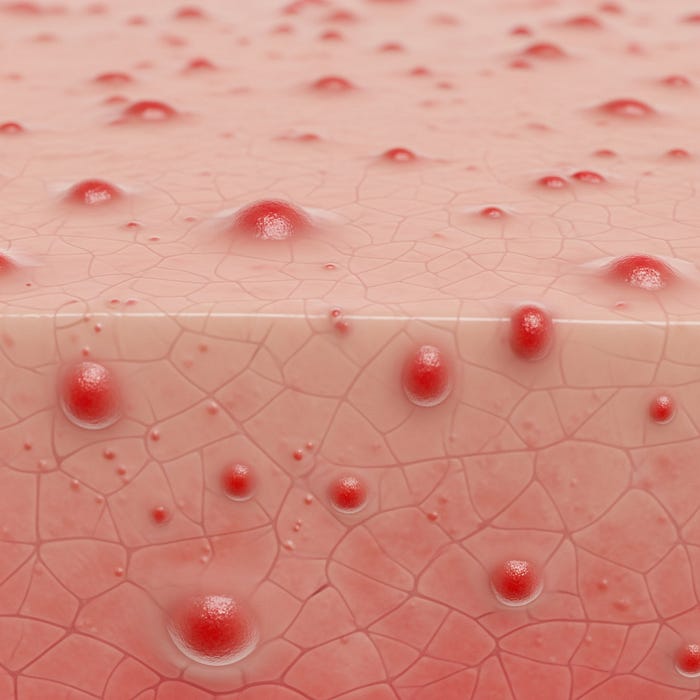Chronic Spontaneous Urticaria (CSU) is a dermatologic condition defined by the recurrence of hives, angioedema, or both for more than six weeks, without any identifiable external trigger. Affecting approximately 0.5%–1% of the global population, CSU is more than a skin condition — it is a chronic inflammatory disease driven by mast cell dysregulation and autoimmunity. Recent advances in pathophysiology and biologic therapies are transforming how CSU is diagnosed and managed.

Request a sample copy of the CI report at: https://www.datamintelligence.com/download-sample/chronic-spontaneous-urticaria-treatment-market
What Causes CSU?
CSU involves the spontaneous activation of skin mast cells, which release histamine and other inflammatory mediators. This results in transient wheals (hives), redness, swelling, and itching.
In around 40–50% of patients, the condition has an autoimmune basis, either due to IgG autoantibodies against the IgE receptor (FcεRI) or against IgE itself. In the remainder, the cause is idiopathic. Common exacerbating factors include stress, infections, and NSAIDs.
Clinical Presentation
Key features of CSU include:
* Daily or near-daily itchy wheals lasting <24 hours
* Angioedema (in ~40% of cases), particularly on the face, lips, and extremities
* Normal lab values (no eosinophilia or systemic signs)
* Disruption of sleep, work, and quality of life due to persistent itching
CSU is diagnosed clinically; allergy testing is often unnecessary unless food or drug reactions are suspected.
First-Line Therapy: Second-Generation Antihistamines
Modern non-sedating H1 antihistamines (e.g., cetirizine, loratadine, fexofenadine) are the first-line treatment. Up to fourfold doses are sometimes required for symptom control. They work by blocking histamine receptors without significant CNS side effects.
Second-Line Therapy: Biologics and Immunomodulators
Patients who fail high-dose antihistamines may be candidates for biologic therapy.
Omalizumab (Xolair):
A monoclonal antibody that binds free IgE, omalizumab is the first and only biologic approved for CSU. Clinical trials show response rates of 60–70% in antihistamine-refractory patients, with symptom improvement within weeks.
Cyclosporine:
Used off-label for severe CSU unresponsive to omalizumab, cyclosporine suppresses mast cell activation. However, nephrotoxicity and hypertension limit long-term use.
Emerging Therapies: Targeting Mast Cell and Autoimmune Pathways
The next wave of CSU management includes:
* Ligelizumab: A next-generation anti-IgE antibody with higher affinity than omalizumab
* Bruton’s Tyrosine Kinase (BTK) inhibitors: Modulate mast cell signaling pathways
* Anti-Siglec-8 therapies: Aim to induce apoptosis in eosinophils and inhibit mast cells
* IL-5 and IL-4/13 inhibitors: Under investigation in eosinophilic or atopic variants of CSU
These therapies may offer faster onset, longer remission, and fewer systemic effects.
Diagnostic Workup and Monitoring
Routine laboratory tests are typically normal in CSU. However, tests may be used to rule out differential diagnoses (e.g., urticarial vasculitis or thyroid disease):
* CRP/ESR: Rule out systemic inflammation
* Thyroid autoantibodies: Positive in 20–30% of CSU patients
* Autologous serum skin test (ASST): Indicates autoreactive CSU in some centers
Patient-reported outcomes, such as Urticaria Activity Score (UAS7), help monitor disease severity and treatment response.
Addressing Unmet Needs and Quality of Life
CSU significantly impacts mental health, with patients often reporting anxiety, depression, and social withdrawal. Access to biologics remains limited in many regions due to cost or insurance restrictions.
To improve outcomes, healthcare systems must:
* Ensure early referral to specialists
* Improve insurance coverage for omalizumab
* Support patient advocacy and education
What’s Next: Toward Individualized, Durable Control
Research is increasingly focused on identifying biomarkers to stratify patients by treatment response. Autoantibody profiling, basophil activity tests, and cytokine signatures may help personalize care.
Future goals include:
* Achieving remission without continuous therapy
* Identifying early responders vs. non-responders to biologics
* Combining biologics for synergistic control
* Expanding oral or at-home options for better compliance
Read the full CI Insights report: https://www.datamintelligence.com/strategic-insights/chronic-spontaneous-urticaria-csu
Conclusion: A New Era in CSU Management
CSU is now recognized as a manageable immune disorder, not just a skin rash. With biologic therapies and precision diagnostics, long-term control and remission are becoming achievable goals for patients worldwide.
About DataM Intelligence
DataM Intelligence 4Market Research LLP delivers real-time competitive intelligence across autoimmune, immunologic, and rare disease spaces. Our insights span clinical pipelines, regulatory benchmarks, and commercialization strategies for stakeholders in global life sciences.
???? Visit: www.datamintelligence.com
Comments on “Unlocking Relief: The Competitive Landscape of Chronic Spontaneous Urticaria in 2025 and Beyond”